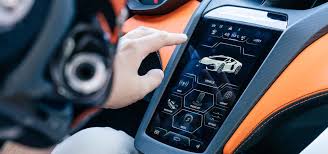
In the rapidly evolving landscape of automotive technology, HMI—short for Human-Machine Interface—has become a pivotal element in enhancing the driving experience. Especially in luxury and exotic vehicles, HMIs play a crucial role in bridging the gap between the driver and the complex systems that power these high-end machines.
Definition of HMI
Human-Machine Interface (HMI) refers to the systems and interfaces through which humans interact with machines. In the context of vehicles, HMI encompasses all the touchpoints and technologies that allow drivers and passengers to communicate with and control various vehicle functions. This includes everything from the dashboard displays and touchscreens to voice commands and gesture controls.
Components of Automotive HMI
Dashboard Displays:
Instrument Clusters: Traditional analog gauges are increasingly being replaced or supplemented by digital displays that provide real-time information about speed, fuel levels, engine performance, and more.
Head-Up Displays (HUDs): These project critical information onto the windshield, allowing drivers to keep their eyes on the road while accessing data like navigation directions and speed.
Touchscreens and Infotainment Systems:
Central touchscreens control entertainment options, navigation, climate settings, and connectivity features. High-resolution displays with intuitive interfaces are standard in luxury vehicles.
Voice Control:
Advanced voice recognition systems enable drivers to control various functions—such as making phone calls, adjusting the climate, or setting navigation routes—using natural language commands.
Gesture Controls:
Some modern vehicles incorporate gesture recognition, allowing drivers to perform certain actions (like adjusting volume or accepting calls) with simple hand movements.
Physical Controls:
High-end cars often feature touch-sensitive buttons, rotary dials, and other sophisticated input methods that complement digital interfaces for a seamless user experience.
Biometric Systems:
Incorporating technologies like fingerprint scanners or facial recognition, biometrics enhance security and personalize the driving experience by adjusting settings based on the recognized individual.
Importance of HMI in Luxury and Exotic Vehicles
Enhanced User Experience:
HMIs in luxury cars are designed to provide a seamless and intuitive interaction, ensuring that drivers can access and control vehicle functions effortlessly without distraction.
Personalization:
Advanced HMI systems can learn driver preferences and adjust settings accordingly, offering a personalized experience that enhances comfort and convenience.
Safety:
By minimizing the need for physical interaction with controls and providing information in an easily digestible format, HMIs contribute to safer driving by reducing driver distraction.
Integration with Advanced Technologies:
Luxury and exotic vehicles often incorporate cutting-edge technologies like autonomous driving features, which rely heavily on sophisticated HMI systems to communicate with the driver and manage the vehicle’s operations.
Aesthetic Appeal:
In high-end vehicles, the design of the HMI is not just functional but also a key element of the car’s overall aesthetic, contributing to the vehicle's luxurious feel and sophisticated image.
Examples of Advanced HMIs in 2025 Luxury and Exotic Vehicles
Augmented Reality Dashboards:
These dashboards overlay digital information onto the real-world view, providing enhanced navigation, hazard warnings, and vehicle diagnostics directly within the driver’s line of sight.
Smart Glass and Interactive Windshields:
Incorporating HMI elements, these windshields can display navigation prompts, incoming call notifications, and other relevant data without obstructing the driver’s view.
Adaptive Voice Assistants:
AI-driven voice assistants in luxury cars can understand context, anticipate driver needs, and engage in more natural and dynamic conversations, making interactions more fluid and less mechanical.
Haptic Feedback Controls:
Touchscreens and touchpads integrated with haptic feedback provide tactile responses to user inputs, enhancing the feel of control and improving user interaction without requiring visual confirmation.
The Future of HMI in Automotive Design
As technology continues to advance, HMIs are expected to become even more sophisticated and integrated into every aspect of the driving experience. Future developments may include:
Enhanced AI Integration:
More intelligent systems that can predict driver intentions and adapt in real-time to changing conditions.
Virtual Reality Interfaces:
Immersive VR interfaces that provide a more engaging and interactive experience for drivers and passengers.
Seamless Connectivity:
Greater integration with personal devices and smart home systems, allowing for a more connected and synchronized lifestyle.
